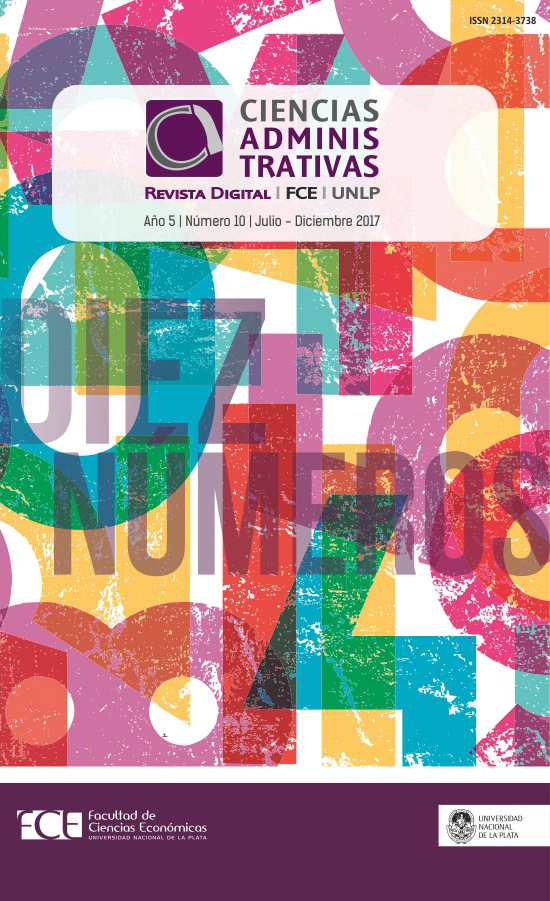Efficiency in financial markets and forecast of asset prices
DOI:
https://doi.org/10.24215/23143738e011Keywords:
Financial markets, market efficiency, behavioral finances, speculative bubbleAbstract
The present work aims to analyze the efficiency in financial markets, by analyzing the positions of the 2013 Nobel Economy prize winners, who obtained this recognition because of their empirical contributions concerning the prediction of the behavior of financial asset prices, based on different theoretical foundations.
The Efficient Markets Theory of Eugene Fama is analyzed, as well as, irrational behaviors of investors and the generation of speculative bubbles from the perspective of Robert Shiller, and finally Lars Peter´s contributions with the Generalized Model of Moments.
It concludes that markets become more efficient, when analysts believes that there are more inefficient and competes in the search of information in order to take advantage of that inefficiency.
Normally analysts act on the basis of imperfect markets, using technical analysis, carrying out fundamental reviews and accepting that privilege information exists; this reality make markets more efficient.
Market efficiency is half-truth; financial asset prices seem to frequently reflect its intrinsic value to a certain extent and in specific situations, widespread irrational behaviors generates bubbles.
Downloads
Metrics
References
Fama, E. F. (1970). “Efficient capital markets: a review of theory and empirical work”. Journal of Finance, (25), 383-417.
Fama, E. F. y Blume, M. E. (1966). “Filter rules and stock market trading”. Journal of Business, 39 (1), 226-241.
French, K. R. (1980). “Stock Returns and the Weekend Effect”. Journal of Financial Economics, (8), 55-77.
Hansen, L. P. (1982). “Large sample properties of generalized method of moments estimators”. Econometrica, (50), 1029-1054.
Kahnemann, D. y Tversky, A. (1982) "Psicología de las Preferencias". Revista Investigación y Ciencia, (66), 100-106.
Kindleberger, C. P. y Aliber, R. Z. (2012) “Manías, pánicos y cracs: historia de las crisis financieras". Barcelona, Editorial Ariel.
Malkiel, B. G. (1973). A randon walk down Wall Street. Estados Unidos: W. W. Norton & Company, Inc.
Ritter, J. R. (1988). “The Buying and Selling Behavior of Individual Investors at the Turn of the Year”. Journal of Finance, (43), 701-717.
Roberts, H. (1967). “Statistical versus clinical prediction of the stock market”. Documento no publicado, citado por Brealey y Myers, 1993.
Shiller, R. J. (1979). “The volatility of long term interest rates and expectations models of the term structure”. Journal of Political Economy, (87), 1190-1219.
Shiller, R. J. (1981). “Do stock prices move too much to be justified by subsequent changes in dividends?”. American Economic Review, (71), 421-436.
Shiller, R. J. (2003). Exuberancia Irracional. Madrid: Turner.
Shiller, R. J. (2009). El estallido de la burbuja: cómo se llegó a la crisis y cómo salir de ella. Barcelona: Planeta.
Shiller, R. J. (2012, octubre) Entrevista realizada por Federico Fernández de Santos en la Fundación Rafael del Pino, España, durante la presentación del libro “Las finanzas en una sociedad justa: dejemos de condenar el sistema financiero y, por el bien común, recuperémoslo”, publicado en español por Deusto.
Downloads
Additional Files
Published
How to Cite
Issue
Section
License
Those authors who have publications with this journal, agree with the following terms:
a. Authors will retain its copyright and will ensure the rights of first publication of its work to the journal, which will be at the same time subject to the Creative Commons Atribución-NoComercial-CompartirIgual 4.0 Internacional (CC BY-NC-SA 4.0) allowing third parties to share the work as long as the author and the first publication on this journal is indicated.
b. Authors may elect other non-exclusive license agreements of the distribution of the published work (for example: locate it on an institutional telematics file or publish it on an monographic volume) as long as the first publication on this journal is indicated,
c. Authors are allowed and suggested to disseminate its work through the internet (for example: in institutional telematics files or in their website) before and during the submission process, which could produce interesting exchanges and increase the references of the published work. (see The effect of open Access)




































